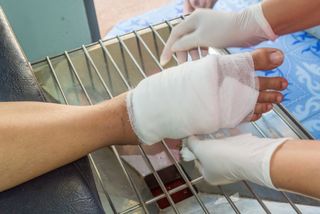Wound Care Specialist

Types of Wounds and Ulcers
- Diabetic Wounds and Ulcers
If a person who is diabetic gets cut or scratched, the wound itself may take longer to heal due to
- Poor Circulation – restricts the body to healing itself
- Reduced Sensation – reduces the ability to feel that there is an injury
- Nerve Damage - reduces the ability to feel that there is an injury
The result of a wound can easily lead to infection, if not treated promptly and thoroughly.
Diabetic Foot Care
- Check for wounds
- Wash feet daily
- Wear socks to bed
- Check shoes
- Never walk barefoot
- Do not smoke
Treatments
- Compression Therapy
- Skin Grafts
- Debridement
- Pressure-Off Loading
- Amputation – Extreme Cases
- Infected Wounds
Infected wounds are simply the outcome of bacteria taking over the wound after the body was unable to heal itself. If left untreated or if the person has a weak immune system can result in the wound to not heal properly and leading to infection.
The treatment of infected wounds is to be properly cleaned and dressed to help the body combat the bacteria. In some cases medication may be taken to help fight the bacteria. If left untreated the bacteria can deteriorate the muscle, bone, and surrounding skin.
- Pressure Ulcers
Pressure Ulcers usually occur in the foot when there is constant pressure or friction. It can be a red spot or in some severe cases affect the tissue. This is the most common type of ulcer because the constant pressure that is placed on the foot with walking. Blood circulation lessens and causes damage to the skin. Other factors could include poor nutrition, health, and excessive moisture for long periods of time.
Stages of Pressure Ulcers
- Stage 1 – Area is red
- Stage 2 – Skin is broken
- Stage 3 – Ulcer is deep and the tissue becomes yellowish
- Stage 4 – The ulcer has reached the bone
Treatments
- Relieve pressure by elevating the foot
- Stage 1 – wash area gently with mild soap and water
- Stage 2 – Ulcers should be cleaned with a salt water rinse to remove loose, dead tissue.
- Keep the sore covered with dressing
- Stage 3 & 4 – will need to be treated by a doctor
- Arterial Ulcers
When there is a lack of proper blood flow to the foot, heel, or ankle an Arterial Ulcer can occur.
Symptoms
- Ulcers found on the tip of toes, heels, or the outer ankle
- Can move to the tendon and cause pain
- Color of skin can change to yellow, black, or brown
Treatments
- Clean wound thoroughly to prevent infection
- Regain proper blood flow



